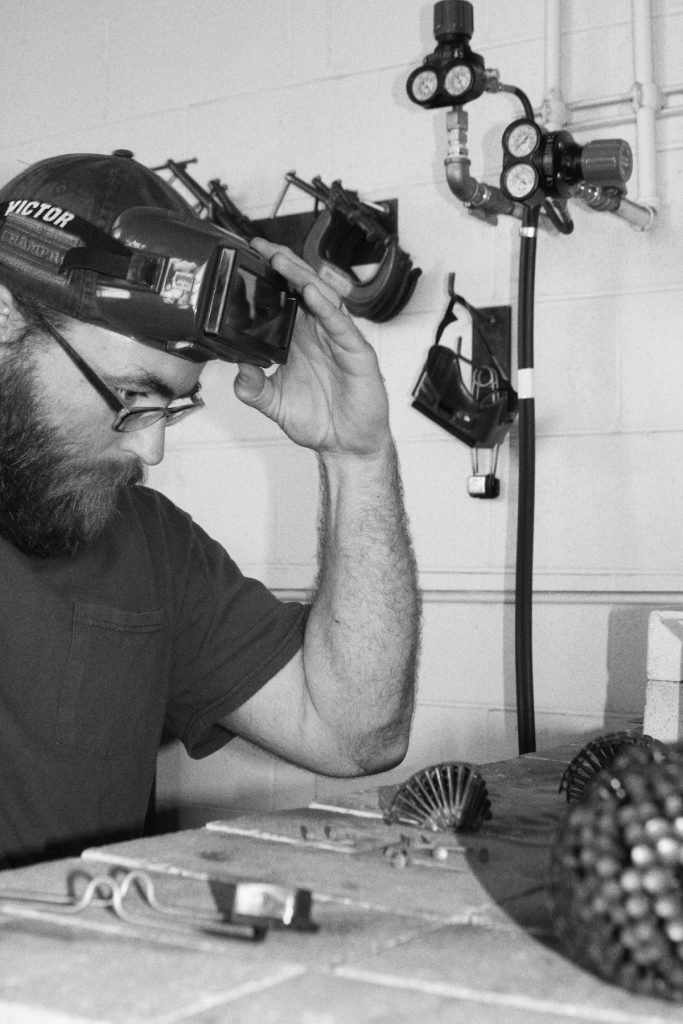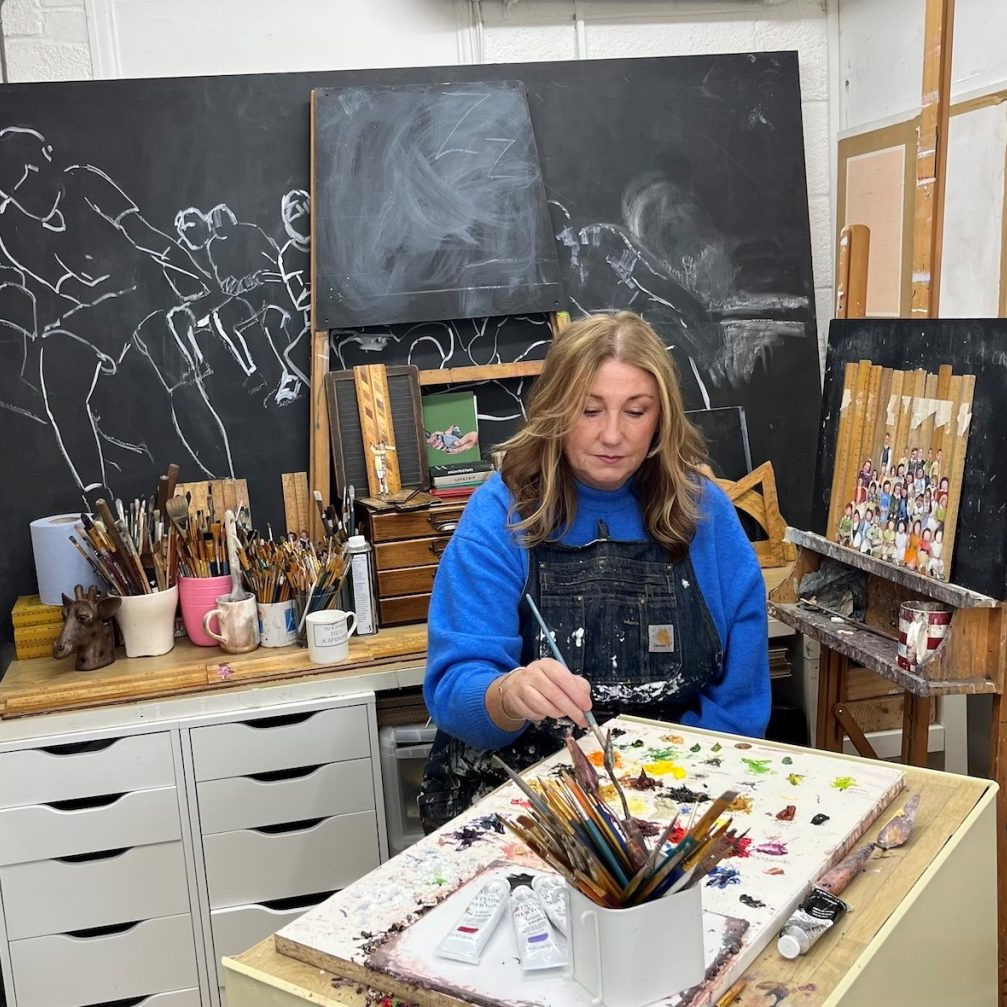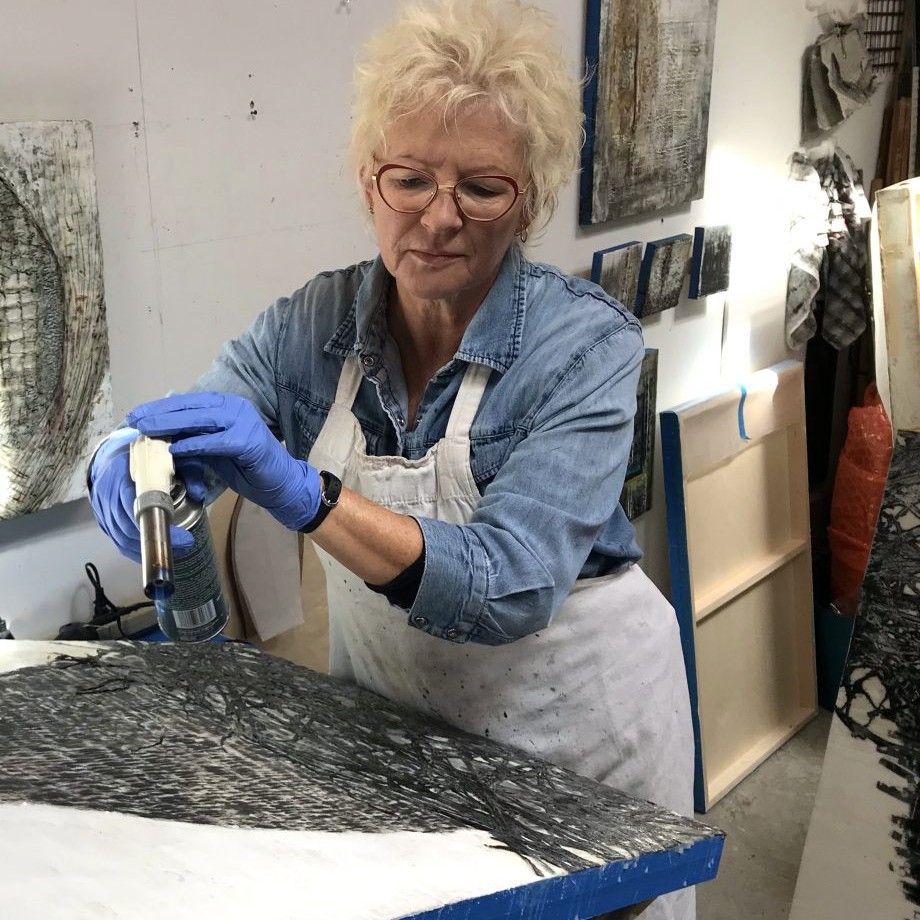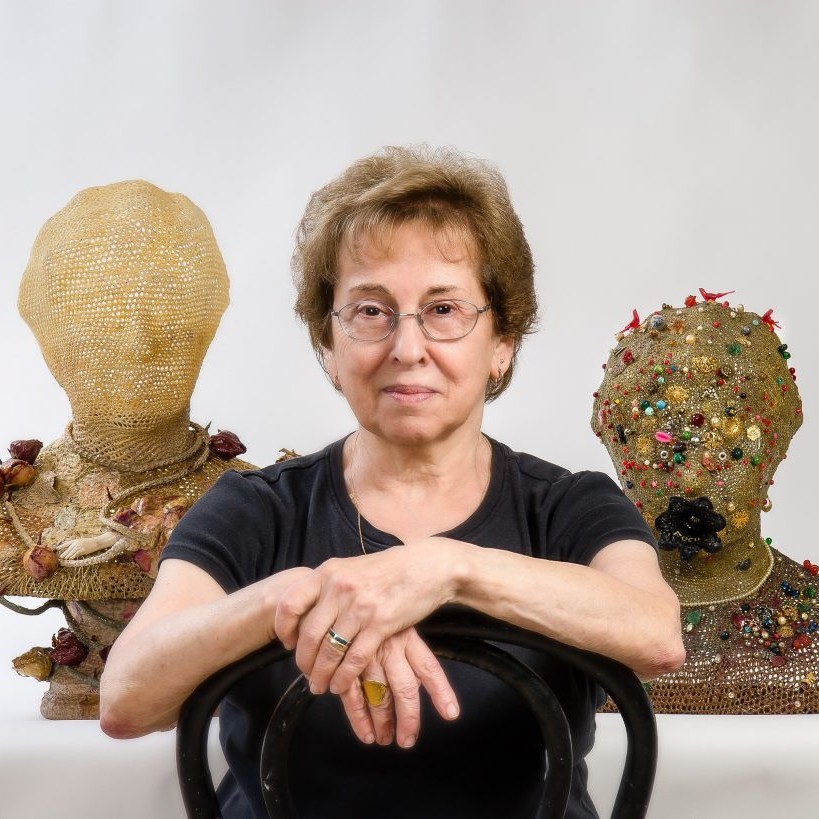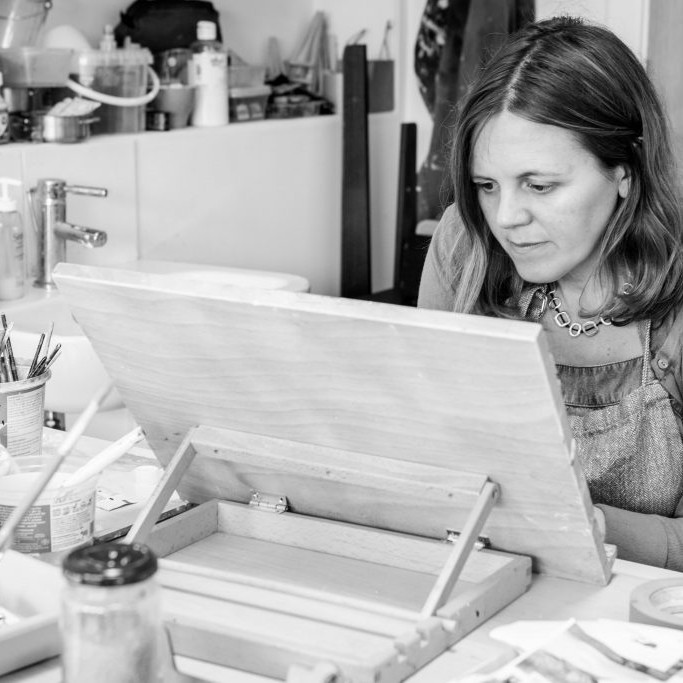Jonathan Whitfill Mixed Media - Texas, USA
Media
Expand on the inspiration of the work?
Almost all of the work that I make comes from language based concepts of individual units combining to make larger groupings that give some overall meaning. The completed visual piece then echoes either a formal element or a conceptual meaning with regards to its individual components.
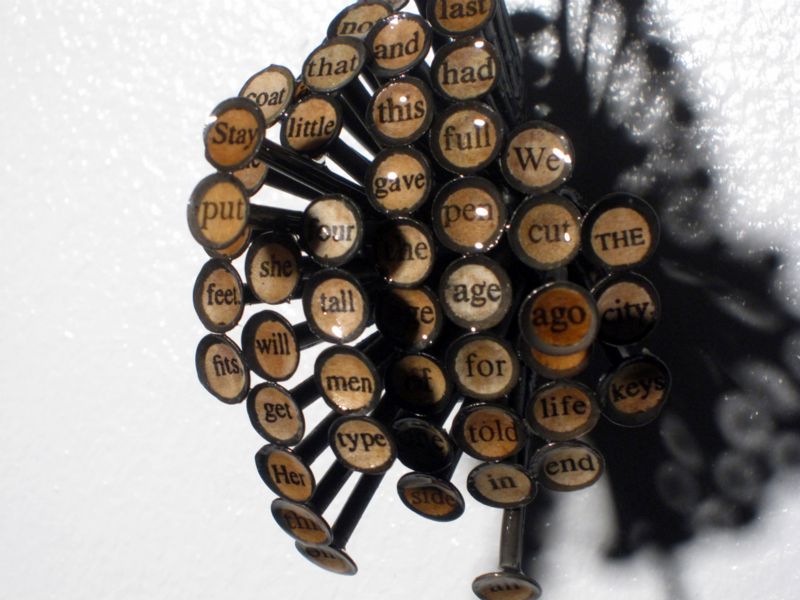
Can you discuss the size of this work?
The pieces that are from this body of work are typically intimate in scale. This is mostly due to the media limitations, however I have made some of these pieces with as many as 1150 individual pieces welded together.
When I sit down to make this type of work I am usually drawn to constructing smaller groupings. This is in some part due to the conceptual framework that supports my studio practice. Individual units brought together into sets of 5-8, then those rows are brought together in groups of 4-5, etc. It’s like speaking a language.
Am I meant to be able to read a message within the groupings?
When I first started making these pieces, the text was random on purpose. Many years before, I preformed a work where I numbered around 3000 words as they came randomly out of a satchel. I then went back and complied a list showing what order the words were removed – essentially, reading what had been said by the random draw. I was astonished to find segments of words that still gave meaning to a reader. I have later come to realize that this is what human beings have a tendency to do without provocation. We want to make sense of randomness, or maybe even this is an innate need leftover from some involuntary survival trait within our evolutionary development – either way, we try to make sense of random words.
Since the conception of these pieces I have changed my process regarding readability. This is in large part due to my brother, Patrick Whitfill, a poet. I had the opportunity to have a residency in which he was able to stay with me for a couple of weeks, and during that time we collaborated on a few of these pieces. Now I try to emulate some of the tricks of working with a limited resource of prose, and still exact meaning – things my brother taught me.
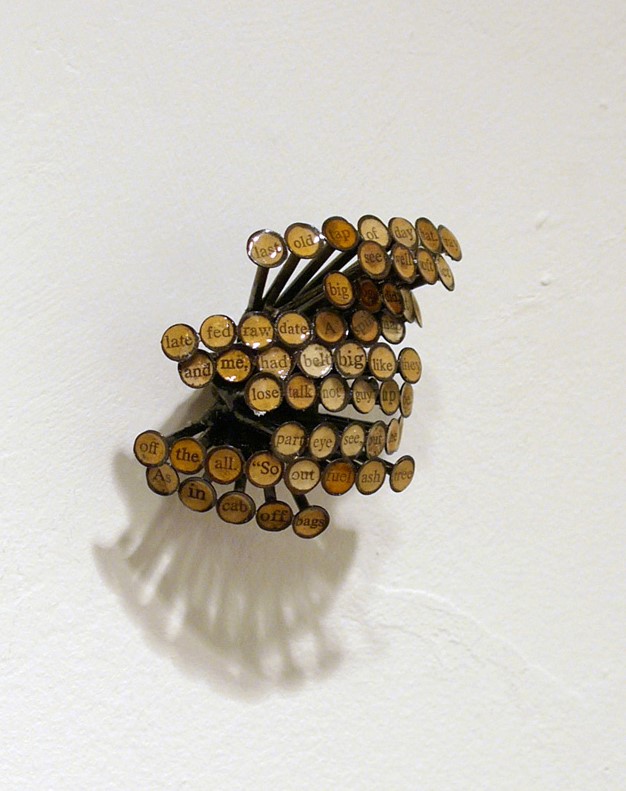
Will you reveal where the type comes from?
It is a common misconception that these pieces originate from old type, or typewriter keys. They are actually nails. I set up and weld individual nails into small rows, then weld the rows together to make the form I desire. After I have welded the nails together I take many different pages from discarded books and using a hole punch, I remove small words that fit inside the punch diameter. After I have removed enough words for a piece, they are arranged and glued upon each of the nail heads. The last step in the process is giving the entire piece a few coats of clear plastic resin to seal the piece from oxidation. So, yes – I get the media to make these pieces from the local hardware store.
Within each group are there the same number of nails?
No, the number of nails varies with the piece, and the formal decisions that I make while I’m welding.
Is the pattern mathematical?
Ideas of efficiency and Geometry always are present in the process, and are revealed through the final object. Sometimes the pattern I’m using as a model is very mathematical, but most times I let the forms that are being produced influence my formal decisions. On occasion, I like to make rules for my production that I think I should follow, it makes my process feel controlled and usually that methodical action becomes a kind-of studio meditation.
Shredder
Discuss the inspiration behind this series?
I have destroyed the original purpose of more books than anyone I have ever met. I have not read every book that I have brought to this altered state. Many of the items I have destroyed were well made, beautifully crafted functional objects of knowledge and potential enjoyment. Constructed from discarded encyclopedias, dictionaries, and paper-back novels these formal found object sculptures pay homage to a rapidly diminishing delivery item of knowledge while stimulating concepts of longevity and beauty albeit in an altered state. Yet doing what I do comes with some guilt.
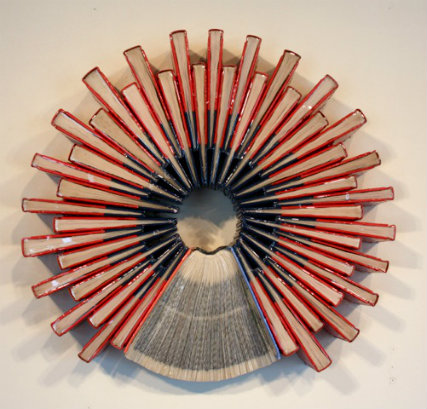
I use rationalization to continue working and lighten the weight I have placed on my shoulders. A series of small rational thoughts about preservation, homage, and ensuring the aesthetic value of the book for future generations usually births the force needed to rip through another page. The thought that publishers, printers, and authors are using digital media avenues with increasing fervor concerns me, but assuaging my conscience is the knowledge that the plastic based resin seeping into these old tomes is a fitting tomb, a glass casket if you will. Seeing boxes of books left on my front porch by un-named donors gives the feeling that when books are to die, they can go to a different place with a new more permanent form. Knowing that Libraries are gifting me their old treasures, saving them from a warehouse waiting to be burned, helps guide me through the process of taking away the most important aspect of these books, readability. Only leaving the glistened husks and the surface appearance is regrettable, but even a facade is sometimes better than nothing…
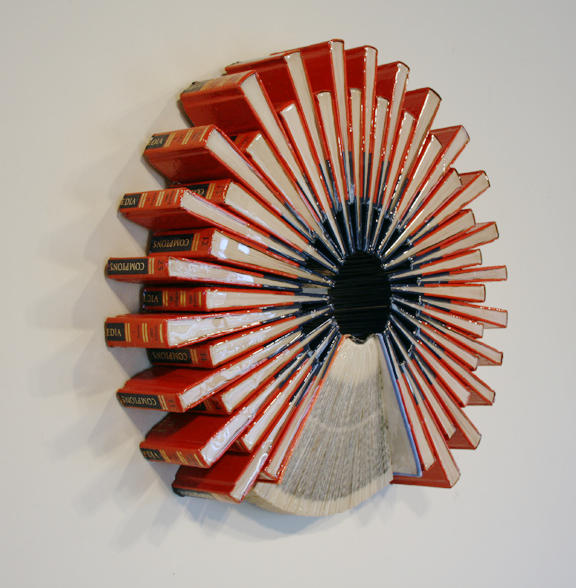
Discuss the importance of the circle in your work?
The book wheel series are an investigation of the circular nature of a typically rectilinear form. Recently I have found that my process can become refined to a point that I waste very little, if any, of the remnants from the media that is produced when I construct these pieces. All the extra detritus is utilized to make more pieces from the initial book form. Making a wedge form in order to make more circular objects can be done many different ways. I typically employ tearing or cutting out pages in sequential decreasing thickness until I reach the middle of the book, and then flip the book over and repeat. Another method to make a wedge shape is the repeated folding of each page until the desired shape is acquired. The most important development of process in the last two years in my estimation, is using the angles removed from one project to come back together into a new circular form. This increased efficiency of materials and some applied geometry has made my valuable studio time more productive – increasing quality along with quantity.
The simple and perfect form of a circle, what an elemental delight.
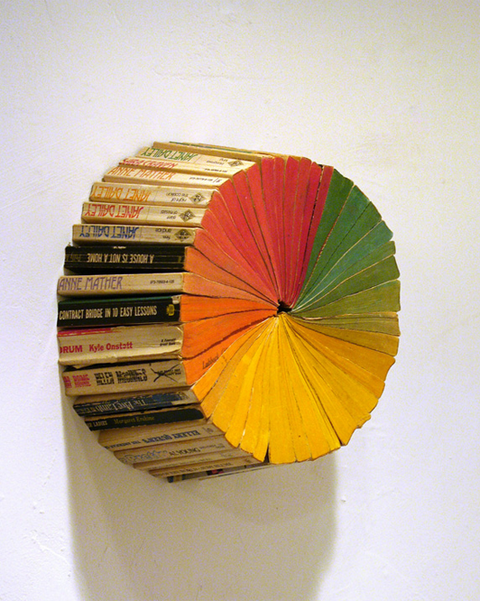
I find that I collect all manner of lids, pipe, and anything else that can be cut to a circle or possibly be manipulated into a circle. My most recent sculptural forms are spheres that are constructed from circles. I have made a few with bottle caps and cut pipe. The importance of the circle in my work is increasingly paramount – however, I can only say that I’m innately drawn to the form, I don’t really know why.
Edges play a large part in this series expand on this?
Some of the best pieces in this series have a tessellated edge, either random or rigidly planned as in the work – USA Yesterday. During the process of making a book-wheel, I enjoy the clean edge, and it even gives me an opportunity to write a small word with the letters identified on the spine. It all really depends on the books being used, and ultimately how they behave – and in doing so, call into being their own design.
Participation
Can you explain in relation to ‘A Turtle Live a Long Time’
The meaning of the title – The idea behind this piece comes from the title. This is one of the rare occasions that I saw this wonderful title while working, and a feeling of the pace of time slipping forward coinciding with the removal of these pages became this title. The topography of text, image, and color being created from the steady habitual erosion of the book is the opposite of continuous growth, tree rings, tortoise shells – it just works.
The technique – Obvious, upon inspection.
Materials used – This is one set of discarded Encyclopedias.
Size – The dimensions are variable. This piece has been hung to fit many different spaces, both vertically and horizontal.
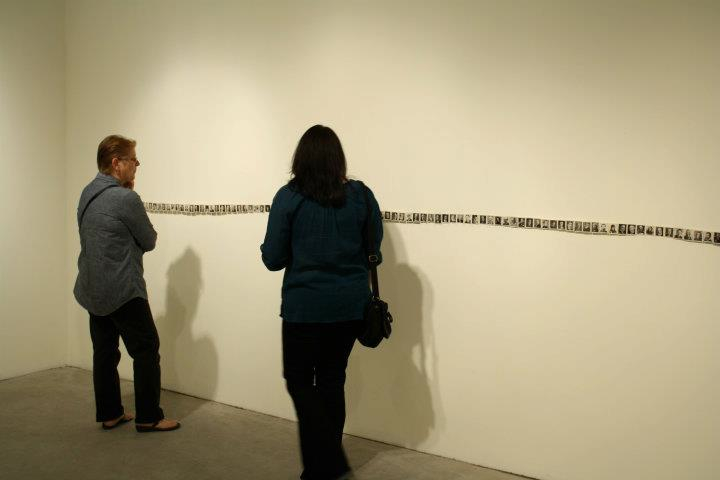
The small portraits can you expand on…
Who they are? – These are almost all of the small portraits from the 1963 World Book Encyclopedia. This was a piece for a Culture Laboratory exhibition named Land Portrait. I took the theme quite literally and made a horizon line from portraits.
Why you have chosen them? – I just couldn’t keep from cutting them out. All of these portraits were in the pages that were removed from my first book-wheel sculpture, SLICE. I wanted to use any media, and waste nothing. The buffalo hunter of the modern book – no waste, use everything, praise the gods for the offer.
What is written on the bottom of each image? – The text at the bottom of each image is the photo-credit.
Discuss your involvement in the ‘Button Project’
The Button Project was an offshoot of having good friends and available media together in the studio during the evening, and my mostly random decision to purchase a button maker. Chad Plunket, Matt Weaver, and I begun by gathering two types of media, encyclopedias and magazines. Being seemingly opposites, the abrupt combination in a brief, yet repeated gesture of these materials has been constantly amusing to us as they come together. Whole pictures are chopped, spliced, and mounted into new compositions forcing the viewer to consider the imagery and iconography in different ways. These new images were then turned into buttons that can be advertised by anyone. By limiting the presentation to three inch buttons, the combinations come into greater focus and can be spread to a large audience, although not quite as large as in their initial debut.
Over the years we have created around 800 original and unique 3” collages mounted to wearable pin-backed button. We have also made a few larger and more ambitious collages as a collaborative team. Honestly, we need to get together more often this summer to finish a work we have been discussing for a while now.
http://thebuttonprojectblog.blogspot.com

Can you explain the importance of mixed media in both your work and your teaching?
I have an affinity towards using re-purposed, or found objects in my work. It seems that since the very infancy of my creative manifestations, I have leaned towards using objects of mass consumption. My first pieces, the ones that lead me to questioning attendance at an Art school, were made from twisty ties at the Grocery store behind my Lab. Since those objects, and my decision to learn techniques and theory supporting Fine Art creation, I have utilized various media including: nails, steel pipe, bottle caps, brass lamps, trophies, automobile wheels, PVC, casted type, and obviously books. The best studio days are ones in which small pieces collected over the years, some manipulated, some just the way they were found, speak to each other as I look for connections, then BAM – they go together. Solving the problem of how they fit is my greatest joy.
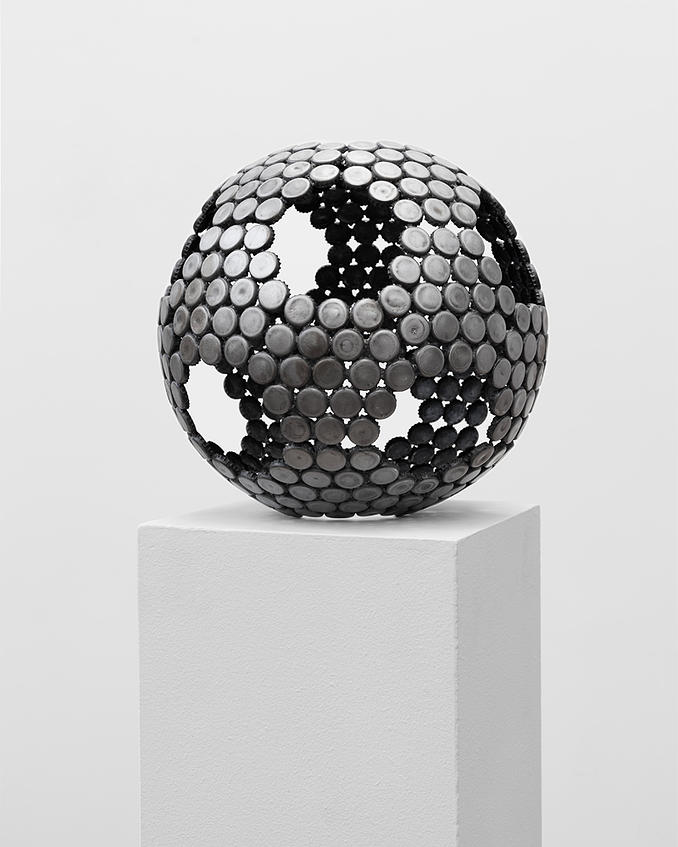
Image by Brett Herron
There is less crossover of using found objects in my teaching, but there is some. When I am organizing laboratory experiments in Physics I at times bring in many seemingly disparate items to challenge my students to solve problems concerning simple machines, or in creating Rube Goldberg devices – a fantastic lab for Physics students studying mechanics.
Expand on the importance of connecting science and art?
I am a very process-oriented artist. My artwork comes from a particular practice that I have refined in the studio over the years, and my ideas have been developing even longer from my personal observations. So in that regard, my artistic practice is much like the scientific method. Each experiment has specific variables that are changed while others are controlled. As the world changes, so do the observations and the experimental process. This leads to a new type of work or product.
I have been observant of the world around me, made educated guesses as to what type of work I want to create, and then I experiment.
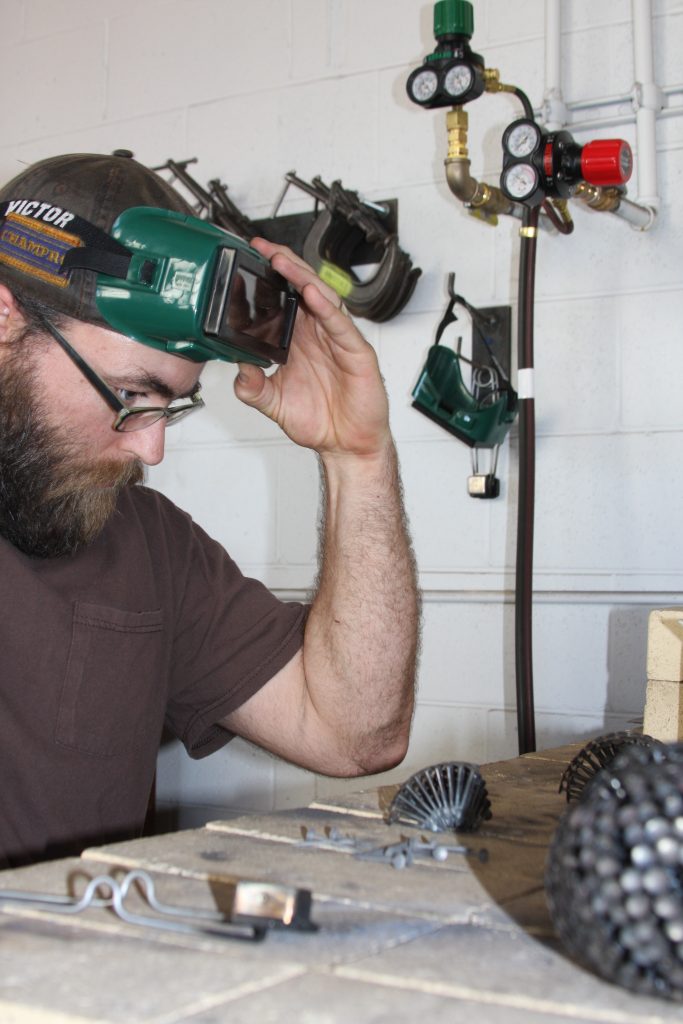
On the other side, Eureka moments usually don’t come from rote analysis or repetition. Nor, does it come from lackadaisical or random leaps of logic. What spurs on intuitive advances in Science is a creative spirit of exploration in variations and flux – which is one of the tenants of artistic practice. Science and Art are not disparate, the shared qualities between disciplines greatly outweigh the differences.
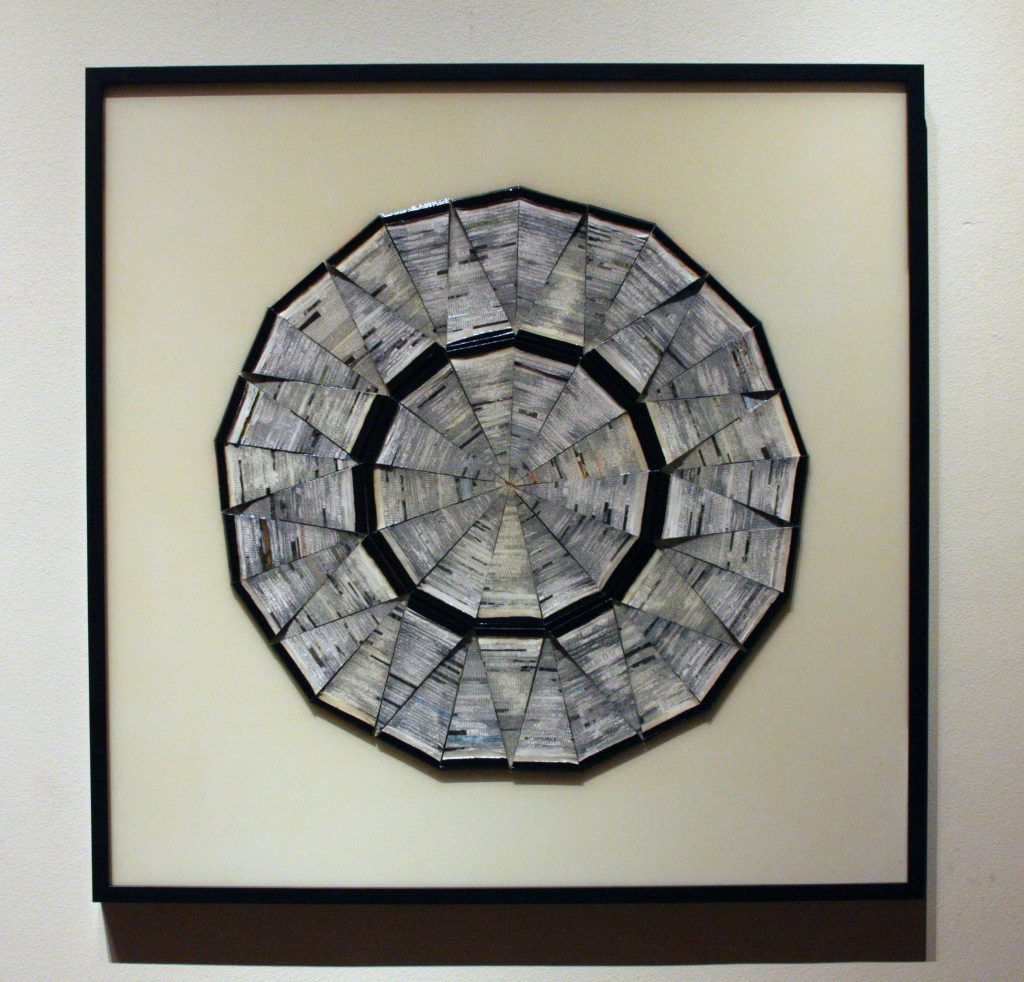
Why do you feel so often that students in science faculties have been screened away from the arts and how should educators be connecting rather than dividing?
I think that if students are being ushered from an arts education to being prepared for a scientific career, the reason is probably purely economic. Our society is being constantly inundated with new technology, chemistry, and biological manipulation – which means there is demand for a trained work force to accommodate that trend, and that work force needs to be educated in the sciences. The financial gain of someone in the field of the Arts is much less probable: other than within the administration of the arts. At least that is true in the Unites States. If you are getting a degree in the arts for education, you will never be well-off. Maybe paying educators considerably less than professionals in the field is some ass-backwards way of getting teachers truly committed to students, yet I digress…
There should be more interdisciplinary bridges in all forms of education from grade school to college. These bridges should be built with the ability for a student to express themselves through any manner of artistic expression. Younger students do this more often in schools, but as we specialize in our studies as older academics the concept of well-roundedness gives way to being an expert in your field. Sadly, the Renaissance Man is seeing a continually diminishing salary.
What lead you to branch out from your science background to a MFA in the Arts?
I teach AP Physics, Regular Physics, Astronomy, and Chess. My undergraduate degree was in the sciences, specifically Biology and Chemistry, but as I was in college I started taking an Art class every semester to blow off some academic steam, so to speak. Directly after college I worked in a Laboratory with Gas Chromatograph machines – how to troubleshoot, repair, and operate these machines in order to run BTEX air, water, and soil samples. The job was incredibly taxing in many regards with an immense learning curve and long hours without additional pay. While there I started making small art creations in my limited spare time in order to blow off some work steam, so to speak. Finally I decided that going back to school for Art was a good idea, and my wife foolishly agreed. The next 5 years were dedicated to my Art education which cumulated into a Masters of Fine Arts from Texas Tech University.
What really lead me to art making was a desire to put things together. What has been a bit of surprise to me in recent years, is that I’m still so enthralled by learning new things in the Sciences that I have found a position that allows me to learn and teach Science during the day – and then evenings, weekends, and of the course the summers are times when I can quench the need to make.
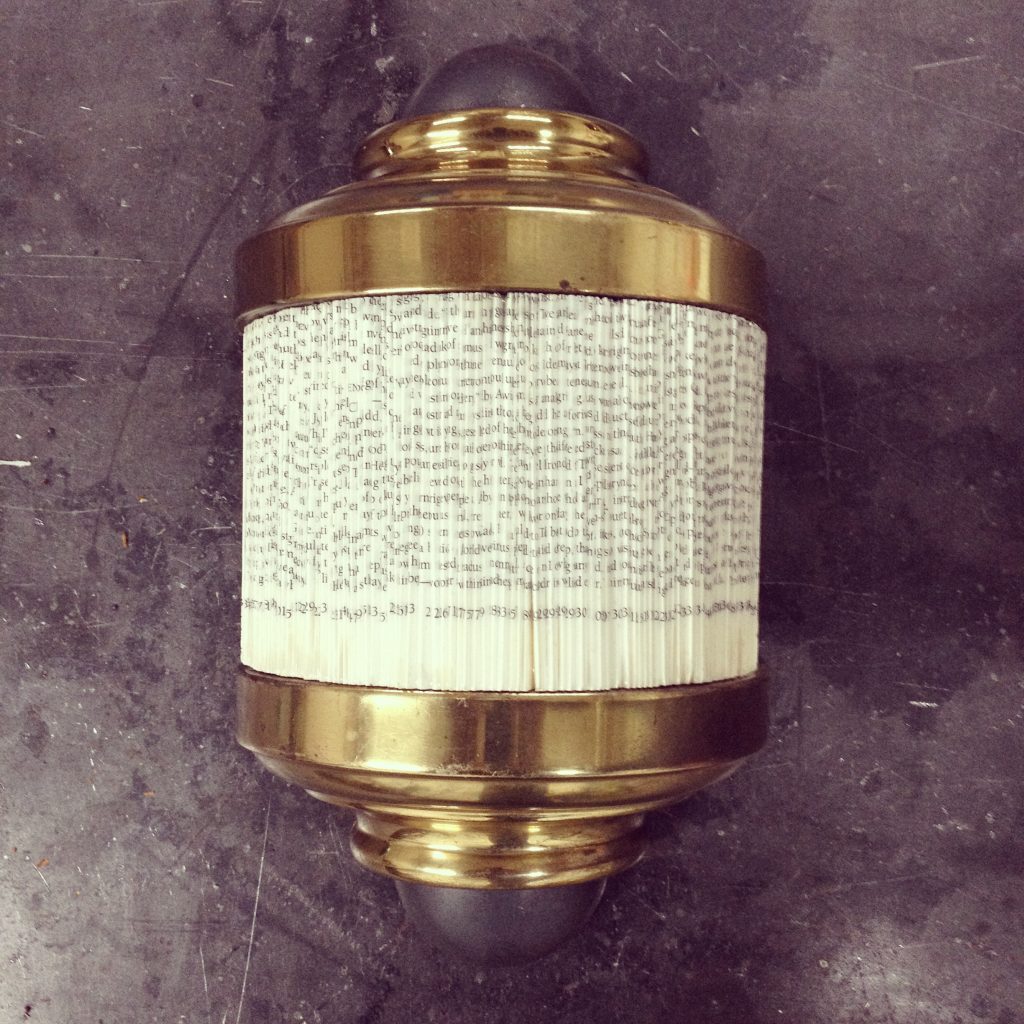
Contact details.
Jonathan Whitfill, Texas, USA
Interview by Deborah Blakeley, June 2015
Think a colleague or friend could benefit from this interview?
Knowledge is one of the biggest assets in any business. So why not forward this on to your friends and colleagues so they too can start taking advantage of the insightful information the artist has given?
Other artists you may be interested in:


